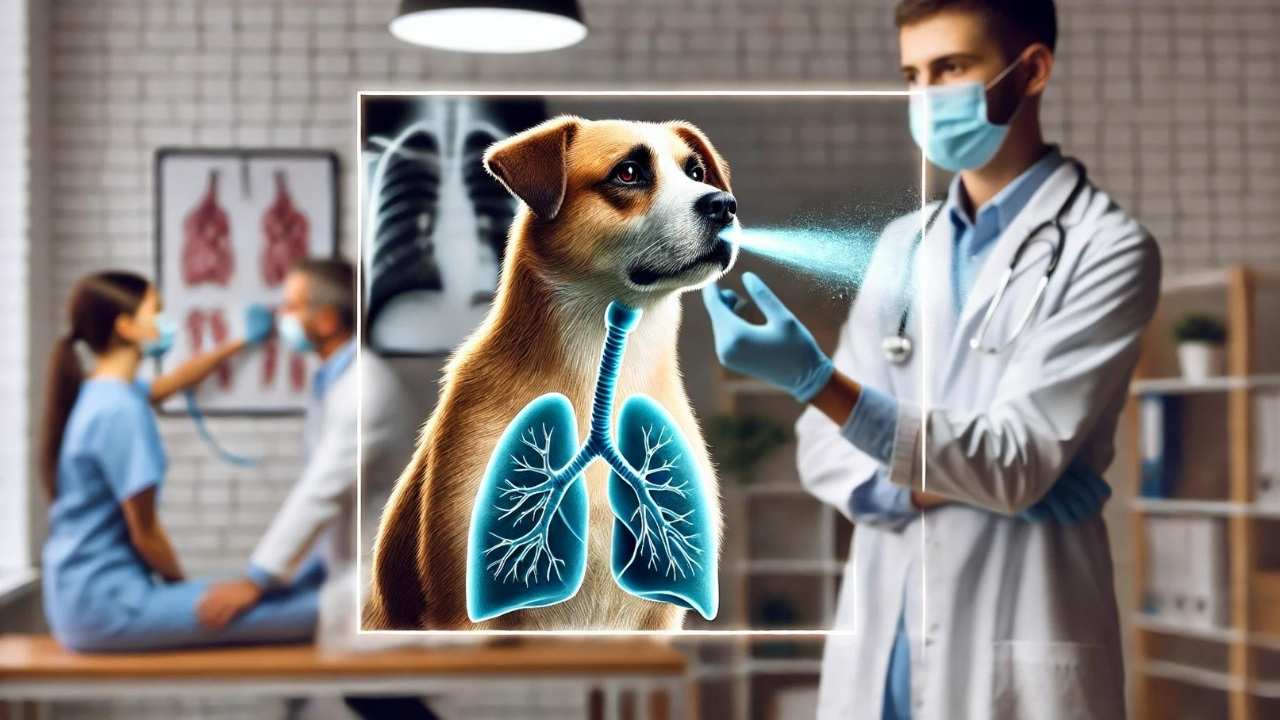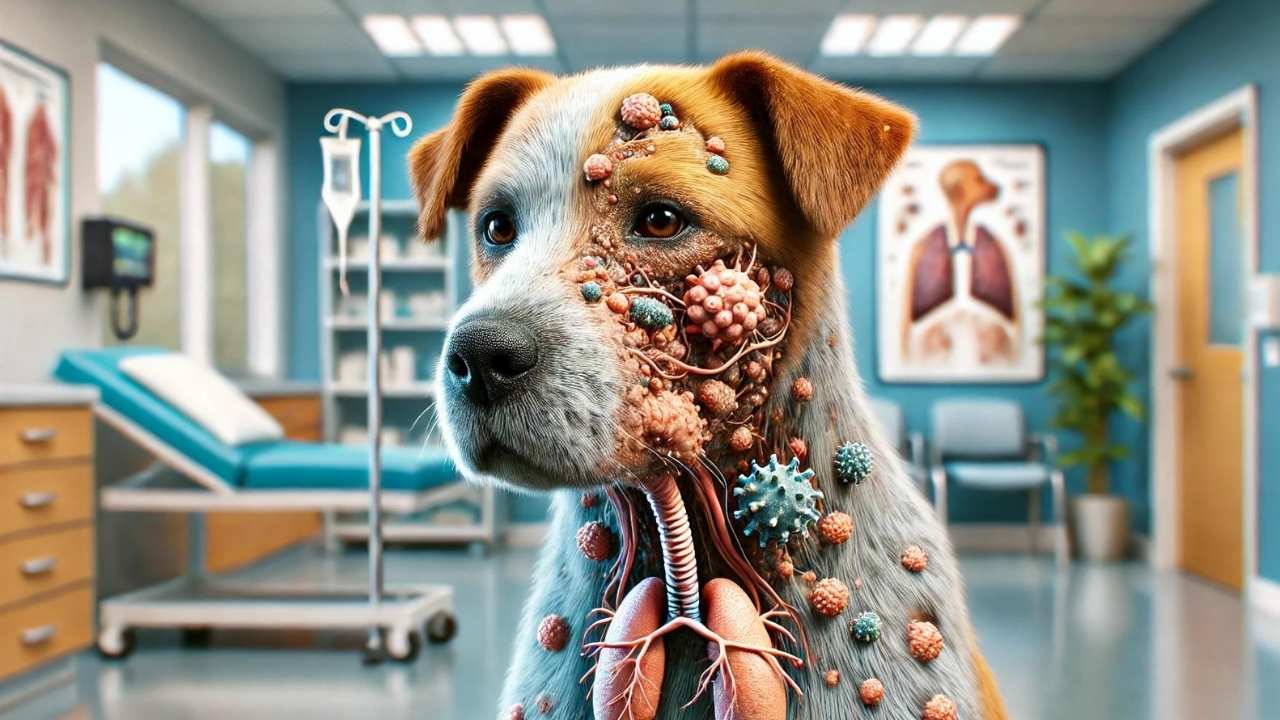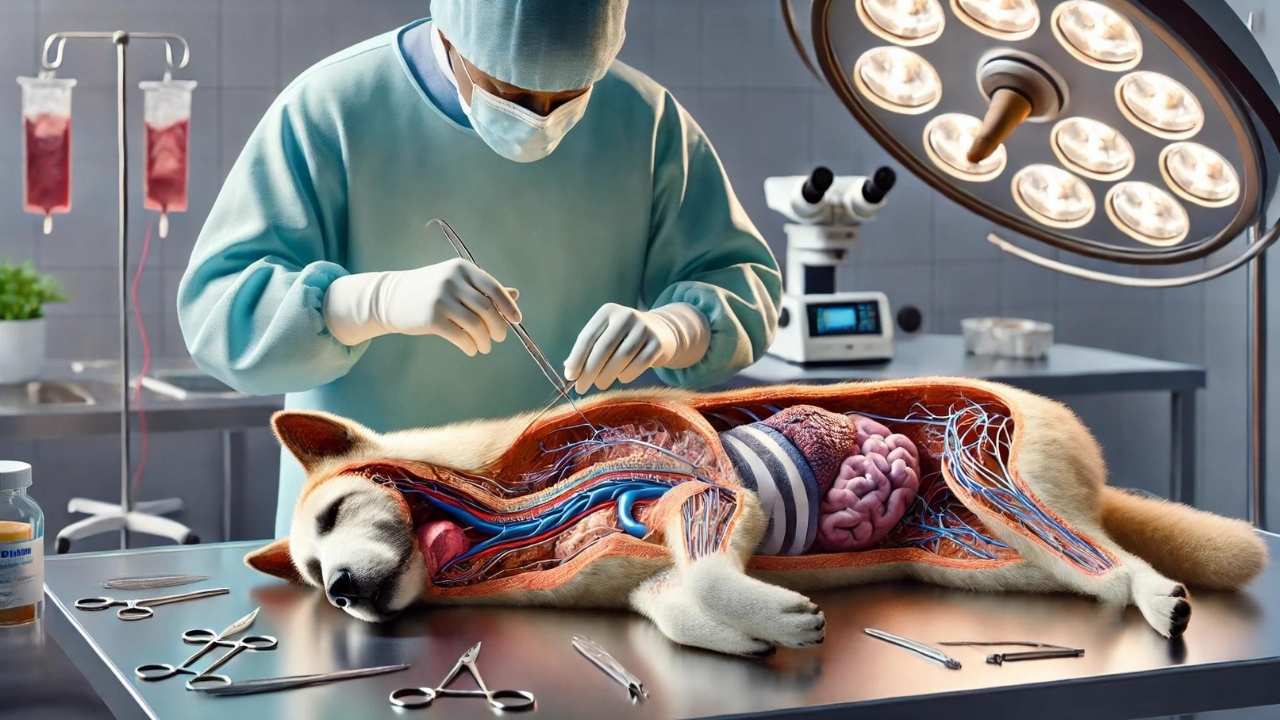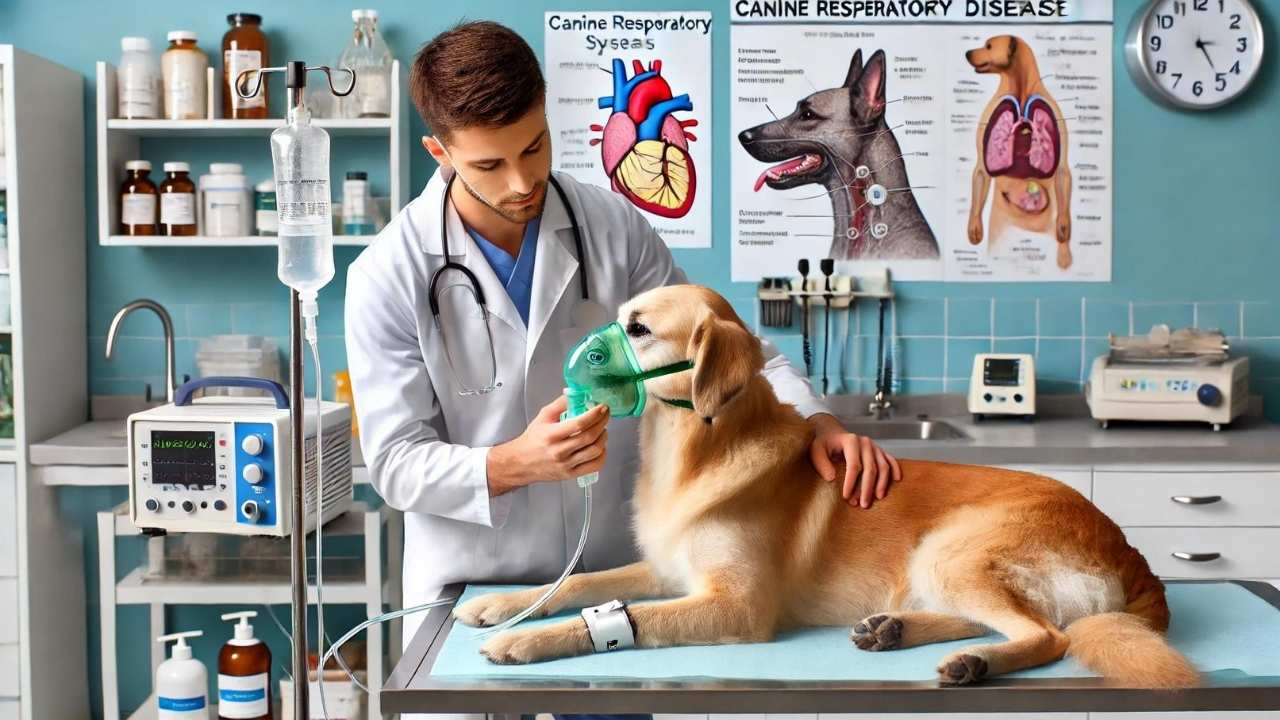Introduction
Dog canine respiratory diseases are a significant concern for pet owners and veterinarians. These diseases can spread quickly, causing outbreaks that affect many dogs. Understanding the causes, symptoms, treatment, and prevention of Dog Canine Respiratory Disease is critical for keeping our pets healthy.
Canine Respiratory Diseases
Dog Canine respiratory diseases are illnesses that affect a dog’s respiratory system, including the nose, throat, and lungs. Dog Canine respiratory disease can range from mild to severe. It can spread rapidly, leading to outbreaks, especially in environments where many dogs are in close contact, such as kennels and shelters.

Dog Canine Respiratory Disease
Types of Respiratory Diseases
- Kennel cough (Bordetella bronchiseptica): It is one of the most prevalent respiratory illnesses in dogs, especially in places with a high dog population. It is distinguished by a persistent, dry cough, which may be accompanied by sneezing and runny nose.
- Canine Influenza (Dog Flu): Two types of canine influenza virus (H3N8 and H3N2) can cause respiratory sickness in dogs. Symptoms include coughing, sneezing, nasal discharge, fever, and fatigue.
- Canine distemper: It is a serious viral infection that affects the respiratory, gastrointestinal, and nervous systems. Coughing, fever, nasal discharge, and neurological indications, including seizures, are some of the symptoms.
- Pneumonia: It can be caused by bacteria, viruses, or fungal diseases. It leads to inflammation of the lungs and airways, causing severe coughing, difficulty breathing, and lethargy.
- Parainfluenza Virus: This is another prevalent cause of respiratory infection in dogs, commonly leading to kennel cough. It leads to coughing, fever, and nasal discharge.
Causes of Respiratory Diseases
Dog Pathogens that can cause canine respiratory illness include:
- Viruses: Canine influenza, distemper, and parainfluenza are major viral causes.
- Bacteria: Bordetella bronchiseptica is a primary bacterial cause of kennel cough. Streptococcus and Mycoplasma species may potentially be involved.
- Fungi: Certain fungi, such as Aspergillus and Blastomyces, can cause respiratory infections, particularly in dogs with weakened immune systems.
- Environmental Factors: Poor ventilation, overcrowding, and stress can predispose dogs to respiratory infections.
- Other Pets: In multi-pet households, diseases can spread between animals, especially if one pet is sick.
Symptoms
Early detection of respiratory problems in dogs can dramatically improve their chances of survival. Early symptoms to watch for include:
- Coughing: This is often the first and most noticeable sign. It may be dry or productive (producing phlegm).
- Sneezing: Frequent sneezing may suggest an upper respiratory infection.
- Nasal Discharge: Clear or colored discharge from the nose is a common sign of infection.
- Eye Discharge: Watery or mucous discharge from the eyes may accompany respiratory disease.
- Mild Fever: A small increase in body temperature may occur.
Severe Symptoms
Understanding Dog Canine respiratory disease and its symptoms can help pet owners recognize when their dog requires medical attention, potentially limiting the spread of infections to other animals. As the condition worsens, more serious symptoms may emerge, demanding quick veterinary intervention about Amantadine for dogs.
- Difficulty Breathing: Labored or rapid breathing, and sometimes open-mouth breathing, can occur as the disease affects the lungs.
- Lethargy: Affected dogs may become very tired and less active.
- Loss of Appetite: Dogs may refuse to eat or drink, leading to dehydration.
- High fever: A considerable rise in body temperature may occur, indicating a more serious infection.
- Weight Loss: Prolonged illness can lead to weight loss and poor body condition.
Diagnosing Respiratory Diseases
Diagnosing Dog Canine respiratory disease involves a combination of veterinary examination and diagnostic tests. Accurate analysis is important for effective remedy and control.
Veterinary Examination
When a dog exhibits signs of respiratory illness, a veterinarian will perform a comprehensive examination to determine the origin of the symptoms. The examination typically includes:
- Physical Examination: The veterinarian will assess the dog’s overall health, including weight, temperature, and hydration levels. They will also look for any visible signs of respiratory distress, such as nasal discharge, coughing, or labored breathing.
- Auscultation: Using a stethoscope, the vet will listen to the dog’s lungs and airways for abnormal noises such as wheezing, crackling, or decreased breath sounds, which can suggest inflammation, fluid buildup, or infection.
- Nasal and Oral Examination: The vet will inspect the nose and mouth for any signs of infection, inflammation, or foreign objects that might be causing respiratory issues.
Diagnostic Tests
To confirm the diagnosis and identify the specific pathogen causing the respiratory disease, the vet may perform several diagnostic tests:
- X-rays (Radiographs): X-rays of the chest can reveal abnormalities in the lungs and airways, such as fluid accumulation, masses, or structural changes.
- Blood testing: It can help diagnose an illness or inflammation. A complete blood count (CBC) can show increased white blood cell counts, whereas particular tests can detect the presence of certain pathogens.
- Nasopharyngeal Swabs: Swabs from the nose and throat can be analyzed to detect the presence of viruses, bacteria, or fungi. These samples are often sent to a lab for culture and sensitivity testing to identify the exact pathogen and its antibiotic sensitivity.
- Bronchoscopy: In some cases, a vet may use a bronchoscope to look directly into the dog’s airways. This procedure can help identify obstructions, take samples, and assess the condition of the respiratory tract.

Dog Canine Respiratory Disease
Treating
Treatment for dog canine respiratory diseases depends on the underlying cause, the severity of the symptoms, and the overall health of the dog. Typically, the treatment approach includes medical therapies as well as supporting home care.
Medical Treatments
- Antibiotics: If a bacterial infection causes the dog’s respiratory condition, the veterinarian will prescribe antibiotics. The choice of antibiotic will depend on the specific bacteria identified and its sensitivity to different drugs.
- Antivirals: Antiviral drugs can help minimize the intensity and duration of viral diseases like canine influenza. Supportive care is often necessary as well.
- Anti-inflammatory Medications: These drugs can help reduce inflammation in the dog’s airways, allowing him to breathe easier.
- Bronchodilators: These drugs help open up the airways, improving airflow and reducing respiratory effort. They are particularly useful in cases of bronchitis or asthma-like symptoms.
- Oxygen Therapy: In severe cases, dogs may require supplemental oxygen to maintain adequate blood oxygen levels. This is typically done in a veterinary hospital setting.
Home Care
- Rest: Ensuring that the dog gets lots of rest is critical for recovery. Limiting physical activity can help reduce stress on the respiratory system.
- Hydration: Dehydration can increase respiratory problems, so it’s crucial to keep the dog hydrated.
- Humidification: Using a humidifier in the dog’s living area can help keep the air moist, making it easier for the dog to breathe and soothing irritated airways.
- Nutritional Support: Providing a balanced diet and, if necessary, supplemental nutrition can help support the dog’s immune system and overall health during recovery.
- Isolation: If the respiratory disease is contagious, it’s important to isolate the sick dog from other pets to prevent the spread of the disease.
Preventing Dog Canine Respiratory Disease Outbreaks
Preventing Dog Canine Respiratory Disease illness outbreaks in dogs requires a combination of vaccination, hygiene, and isolation techniques. These techniques serve to limit the danger of illnesses spreading among dogs, especially in close-contact contexts like kennels, dog parks, and shelters.
Vaccination
One of the most efficient ways to avoid respiratory problems in dogs is by vaccination. Vaccines help build immunity against specific pathogens, reducing the likelihood of an outbreak.
- Kennel Cough Vaccine: This vaccination protects against Bordetella bronchiseptica, which is a major cause of kennel cough. It is especially crucial for dogs who constantly socialize with other dogs at boarding facilities or dog parks.
- Canine Influenza Vaccine: There are vaccines available for both strains of canine influenza (H3N8 and H3N2). Vaccination is suggested for dogs in high-risk situations, such as those in shelters or who compete in dog shows.
- Distemper Vaccine: The canine distemper vaccine is part of the standard vaccination schedule and protects against a serious viral disease that affects the respiratory, gastrointestinal, and nervous systems.
- Parainfluenza Vaccine: Often included in combination vaccines, this protects against another common cause of respiratory infections in dogs.
Hygiene and Isolation
Maintaining basic hygiene and isolating sick dogs are critical for preventing the spread of canine respiratory infections. Clean environments and proper isolation reduce infection risks.
- Clean Environment: Regular cleaning and disinfection of spaces where dogs live, play, and interact can help to limit the presence of germs. This includes cleaning bedding, toys, and feeding areas.
- Hand Hygiene: Pet owners and handlers should practice good hand hygiene, especially after handling multiple dogs. Washing hands thoroughly with soap and water or using hand sanitizer can help prevent the spread of disease.
- Isolation of Infected Dogs: Sick dogs should be separated from healthy dogs to prevent the spread of contagious diseases. This is especially crucial in kennels and shelters, where the danger of transmission is greatest.
- Limiting Contact: During an outbreak, interaction between dogs should be limited. Avoid taking dogs to crowded areas and minimize playdates with other dogs until the outbreak has been contained.
Treatment
Dog Canine Respiratory Disease illnesses are often treated with a combination of medicines and supportive care. Antibiotics are often prescribed for bacterial infections, while antivirals may be used for viral illnesses. Anti-inflammatory drugs help reduce airway inflammation, and bronchodilators can ease breathing difficulties.
Regular check-ups serve to ensure the success of the treatment and allow for quick intervention if the dog’s condition deteriorates. Preventative measures, such as vaccinations and maintaining good hygiene, are essential in managing and preventing future outbreaks of respiratory diseases.

Dog Canine Respiratory Disease
Canine Respiratory Disease 2024
In 2024, Dog Canine Respiratory Disease will be a major worry for pet owners and veterinarians. Disease outbreaks such as canine influenza and kennel cough have underlined the importance of continued surveillance and prevention efforts.
In 2024, the emphasis will be on improving preventive tactics, such as extensive vaccination campaigns and better hygiene in kennels and shelters. Public awareness initiatives are critical for educating pet owners on the need for vaccinations.
Canine Respiratory Disease Advisory
Dog Canine Respiratory Disease illnesses can spread rapidly, particularly in kennels and shelters. Immediate veterinarian care and quarantine of afflicted dogs are critical for preventing outbreaks.
Vaccinations play a vital role in preventing dog canine respiratory disease. Ensure your dog is up-to-date with recommended vaccines to protect against common respiratory infections.
Dog Canine Respiratory Disease Symptoms
Symptoms of dog canine respiratory diseases can range from mild to severe. Early signs include coughing, sneezing, and nasal discharge, which may initially be mistaken for minor ailments. As the Dog Canine respiratory disease progresses, symptoms can become more severe, including difficulty breathing, lethargy, and loss of appetite.
Recognizing these indications early on can greatly improve the prognosis for affected pets. Owners should monitor their pets closely for any signs of respiratory distress and seek veterinary care immediately if symptoms worsen.
Dog Respiratory Illness Map
A Dog Canine Respiratory Disease illness map for dogs can provide significant information about the geographic spread of diseases such as canine influenza and kennel cough. These maps are often created using data from veterinary clinics and public health organizations to track outbreaks and identify hotspots.
Such maps can also help pet owners understand the risks in their area and take precautions against canine respiratory disease. Staying informed about local epidemics can encourage timely immunization and early response to symptoms, hence lowering the burden of respiratory infections on the canine community.
CIRDC
Dogs can contract CIRDC, also known as kennel cough, a highly contagious respiratory infection. It often spreads in areas where many dogs congregate.
Symptoms of CIRDC include a persistent, dry cough, sneezing, nasal discharge, and sometimes fever. Early detection and prompt veterinary care are crucial for effective treatment and recovery.
Preventing CIRDC involves vaccination, maintaining good hygiene, and isolating infected dogs. If their dogs exhibit symptoms of respiratory illness, pet owners should be attentive and seek veterinary care.
CIRDC Dog Symptoms
Canine Infectious Respiratory Disease Complex (CIRDC), commonly known as kennel cough, presents with a range of symptoms. The most visible symptom is a persistent, dry cough that resembles a goose honk. Other symptoms include sneezing, nasal discharge, and gagging or retching.
Early detection of CIRDC symptoms is critical for effective treatment and preventing the spread of the disease. Pet owners should isolate affected dogs and seek veterinary care to manage the symptoms and prevent transmission to other dogs.
Disease Outbreak
Dog Canine Respiratory Disease illness outbreaks can have a large influence on dog populations, particularly in kennels, shelters, and other communal settings. These outbreaks are frequently caused by highly infectious organisms such as canine influenza virus and Bordetella bronchiseptica.
To avoid further transmission, an outbreak requires a coordinated response that includes isolating infected dogs, vaccinating healthy dogs, and implementing strict cleanliness measures. Public knowledge and education regarding the symptoms of respiratory infections, as well as the need for immunization, are critical for disease control.

Dog Canine Respiratory Disease
Conclusion
understanding, preventing, and managing dog canine respiratory diseases are crucial for maintaining dog health. Through vaccinations, good hygiene, early detection, and appropriate treatments, we can effectively control outbreaks and ensure the well-being of our canine companions.



0 Comments